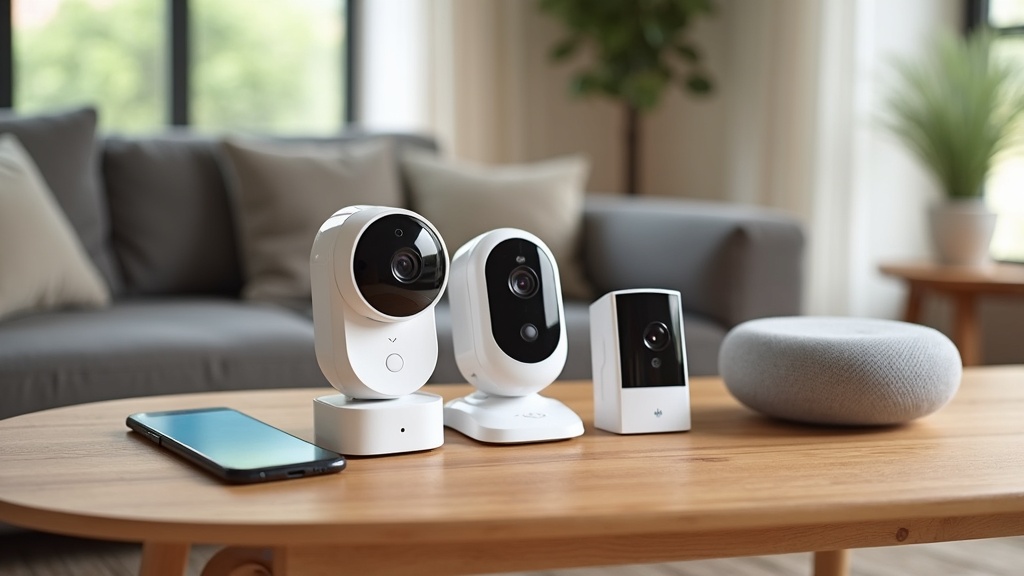If you’re shopping for your very first home security camera, the range of choices can feel a bit overwhelming, especially if you want to stretch your wallet. Cheap doesn’t always mean poor quality, though. I put together this guide to help first-time buyers figure out what to look for when picking out budget-friendly smart security cameras. If you’re new to smart tech, you’re in the right place to track down tips for safeguarding your home without spending a fortune.

Why Start With a Budget-friendly Smart Security Camera?
Smart home security cameras have turned into a popular pick for keeping an eye on your house, garage, or even your backyard shed. For newcomers, starting out with an affordable model is a low-risk way to try out home security tech without spending a ton of money upfront. These affordable models pack features that were once only seen in fancier setups. I’m talking about wireless setups, cloud storage, basic motion detection, and full mobile app controls right from your phone.
These entry level cameras are really handy for things like checking on dropped packages, monitoring pets, or keeping tabs on who’s at the front door. You can often set them up yourself without any fancy tools or calling a pro; just plug them in, link up with your WiFi, and you’re ready to go. It’s as easy as setting up a new toaster.
A bonus is that many of these models keep things user-friendly. The apps guide you through every step, so even if you aren’t super tech savvy, you’ll have your camera up and running fast.
What to Look for in an Entry level Smart Security Camera
The market for budget cameras is loaded with options, but a handful of key features can make a camera truly useful from the start. Here’s what to always check before making a purchase:
- Resolution: Go for at least 1080p HD to make out faces and important details. Some budget cams claim 2K or 4K, but 1080p gets the job done for most first timers.
- Cloud vs. Local Storage: Some models throw in a free cloud tier; others rely on micro SD cards. If privacy matters or you want to avoid monthly fees, look for a camera offering local storage, so you only pay once.
- Smartphone Alerts: Instant app notifications make for peace of mind. Cameras that allow you to adjust motion sensitivity or set activity zones save you from getting spammed whenever a cat walks by.
- Night Vision: Not all budget cams manage low light well. Always check out sample footage and user reviews to get a sense of how a camera handles nighttime conditions.
- Weatherproof Rating (For Outdoor Cameras): If you need to keep an eye on your porch or yard, ensure the camera is IP65 rated or better, keeping it safe from rain and dust.
- Two-way Audio: Handy for chatting with delivery folks or calling your dog inside. Even some super affordable models include this feature.
- App Experience: Since your phone is your viewing window, a clean, intuitive app experience makes everything much simpler. Some bargain cameras suffer from slow, glitchy software, so it’s worth reading app store reviews before buying.
A few other features, such as support for smart home platforms (Alexa, Google Assistant, Apple HomeKit), can also boost your setup, but aren’t always critical for first timers.
Recommended Budget Security Camera Options
A handful of budget brands stand out if you want solid bang for your buck. These choices offer a lot for the price:
- Wyze Cam v3: A low-cost, weatherproof indoor/outdoor use, color night vision, and free cloud storage for short clips. It’s tough to beat for the price.
- TPLink Tapo C200: A popular indoor pick with pan tilt control and sharp 1080p video. The Tapo app is straightforward and rarely crashes.
- Blink Mini: Super affordable, compact, and acts as a seamless companion if you’re already in the Amazon Alexa universe. It’s more for indoor use, since it isn’t weatherproof.
- Eufy Security Solo IndoorCam C24: Nails the basics, supports Apple HomeKit, and offers local video storage with zero forced subscriptions.
These cameras keep showing up on best-seller lists, attract tons of user reviews, and get steady updates from their makers. Having a bigger support base and an easy-to-check warranty adds peace of mind for anyone starting their smart home journey.
Smart Camera Setup: What to Expect
Getting your first smart camera ready is usually very straightforward. Most manufacturers prompt you to scan a QR code, hook up to WiFi, and tap through some simple steps. Keep your WiFi login handy to speed up things. Some cameras include step-by-step voice or visual guides, which are a lifesaver if you’d rather skip poring over thick manuals.
For outdoor installations, you might need to break out a drill to mount the unit, but many indoor models are happy sitting on a shelf or table. I always recommend using your phone’s live camera preview during setup. That way, you can adjust the position to avoid window glare or awkward camera angles.
After the initial install, take some time to poke around your camera app’s settings. Update the firmware, set up custom alerts, and adjust detection zones if you can. Limiting alerts to only the areas and events you care about saves you from constant pings for windblown leaves. Also, rename your cameras clearly in the app—names like “Front Door” or “Backyard” let you find the right feed fast.
Wired vs. Wireless Security Cameras
Are wired or wireless cameras the better choice? This question pops up a lot among new buyers. Wireless cameras are probably best for renters, students, and anyone in a temporary space. If you have strong WiFi, you can put the camera just about anywhere and relocate it as needed. The catch is that wireless cameras rely on batteries or power outlets, so think about your needs and home setup first.
On the other hand, wired cameras shine in permanent setups. Since they don’t depend on WiFi or batteries, they stick around, recording when others might go dark. These systems require extra installation work—running cables through walls isn’t fun—but they’re favored in places where lost footage simply isn’t an option, like offices or retail stores. For folks planning to stick around long term, a wired or hybrid system could be worth considering.
But for most first-timers and folks who need flexibility, a wireless camera is an easy win. Wireless options have improved in connectivity, reliability, and handy features, making them a great starting point.
Security Cameras vs. Surveillance Cameras: What’s the Difference?
Security camera or surveillance camera—which do you really need? The terms often get mixed up, so here’s a quick breakdown. A security camera is most often a smart device you control with an app or your phone. These cameras offer password protection, cloud storage, and fully customizable alerts and settings for personal use.
A surveillance camera is typically part of a larger closed circuit (CCTV) system. These are common in businesses and public venues, streaming live to security monitors or recording straight to a hard drive. They usually require a more complex installation and aren’t always as easy to set up as plug-and-play smart cams.
The distinction has blurred in recent years, since basic home cameras now store video and push alerts just like professional systems. Still, for a do-it-yourself home setup, look for the term “security camera.”
Budget Cameras: Are They Actually Worth It?
Short answer: yes, you can definitely find affordable cameras that offer clear videos, reliable notifications, and bonus features like voice control or color night vision. No, you won’t get every last bell and whistle, but a solid budget camera nails the core functions most people want.
For instance, the Wyze Cam v3 generally costs less than many traditional security monitoring subscriptions, yet packs in weatherproofing, quick motion alerts, and a mix of cloud and local storage. Budget cameras suit renters, students, new homeowners, or anyone watching their spending.
Of course, there are drawbacks: cheaper cameras may mean less responsive customer support, a few more bugs, or less robust cloud services. Picking brands with lots of positive feedback and frequent updates generally sidesteps these pitfalls. Taking ten minutes to read recent reviews really pays off—nobody wants to discover a surprise flaw last minute.
Frequently Asked Questions About Smart Security Cameras
What is the best budget security system?
The Wyze Cam v3 stays at the top of many budget picks. It’s a breeze to use and delivers cloud storage, 1080p HD video, night vision, and both indoor/outdoor flexibility. For multiroom setups, Blink and Eufy offer good deals on combination packs too.
Are cheap security cameras worth it?
Absolutely. Most budget cameras hit the sweet spot for price and functionality, letting first-timers try out at-home monitoring without a big leap. Always check for up-to-date reviews and firmware releases, as features evolve quickly.
Is it better to have wired or wireless security cameras?
Wireless cameras win for easy setup, so they’re great for new folks or renters. If you need nonstop reliability, wired is king but takes more effort. For kicking things off, wireless smart cameras keep things simple.
What is the difference between a security camera and a surveillance camera?
Security cameras are smart devices controlled through your phone and usually aimed at personal use. Surveillance cameras refer to large-scale, professional systems with real-time monitoring and constant recording.
Extra Tips for First-Time Smart Camera Owners
- Keep your camera’s firmware up to date: This helps guard against hacking risks and unlocks fresh features.
- Use a strong WiFi password: Blocking unwanted visitors starts with network security.
- Pick the right spot: Place cameras out of reach and aim for maximum coverage of important areas.
- Monitor battery life (for wireless cams): Plan to charge or swap out batteries regularly so you don’t get caught off guard.
Jumpstarting your smart security doesn’t have to empty your wallet. Once you’re comfortable with your starter camera, you’ll know exactly what to track down when you decide to upgrade or expand your setup down the line.
